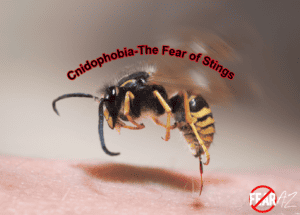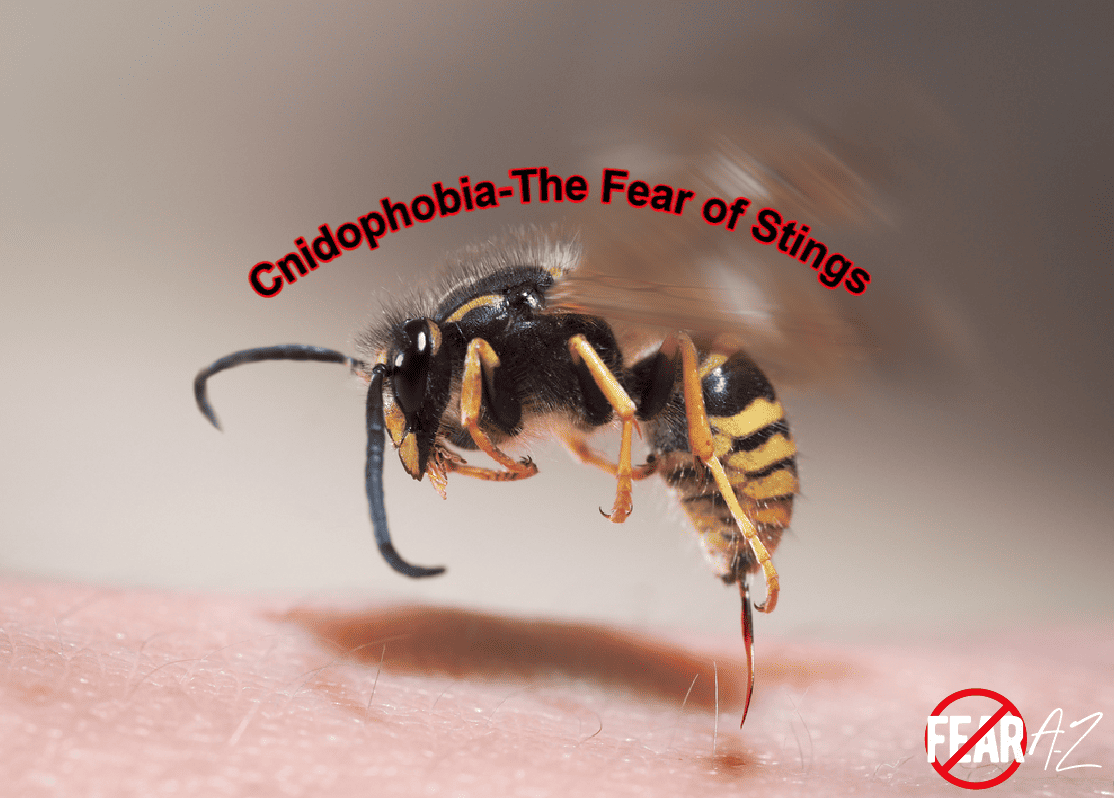Share This Article
Cnidophobia: The Excessive Fear of Stings
Cnidophobia is the extreme fear of stings, such as those from jellyfish, wasps, or bees. It’s not your average fear. It’s more like an intense terror that comes on when someone considers getting stung.
A person suffering from cnidophobia may take extreme measures to stay away from anything that can sting them. Imagine having a constant sense of impending doom whenever you see a bee. It’s unpleasant to feel anxious and worried because of this fear.
There are many insects, invertebrates, ants, scorpions, and even flies that can deliver stings. Stings are nature’s defense for these little creatures. A sting or stings can be uncomfortable to downright excruciating.
It is completely natural to fear being stung or to fear creatures that can sting. Some people, though, have an excessive—almost debilitating—fear of stings, this is called cnidophobia.

Causes of Cnidophobia
Cnidophobia, the fear of stings, can be caused by various factors. Here are several potential causes:
- Past Traumatic Experience – Getting stung in the past, especially if the experience was painful or involved severe allergic reactions, can trigger cnidophobia.
- Learned Behavior – If someone close to you, like a family member, has a fear of stings, you might learn to be afraid of them too through observation and mimicry.
- Media and Movies – Seeing scary stinging scenes in movies or hearing about them in the news can make the fear worse. Your brain begins to associate stings with danger.
- Genetics – Some researchers think there could be a genetic component, meaning you might be more likely to develop cnidophobia if it runs in your family.
- Personality Traits – If you’re naturally more anxious or tend to worry a lot, you might be more prone to developing fears like cnidophobia.
- Lack of Knowledge – Not knowing much about stinging insects and their behavior can lead to unnecessary fear. Education about these creatures can help reduce the phobia.
- Early Negative Encounters – Even small encounters like getting stung by a bee as a child can leave a lasting impression and develop into cnidophobia.
- Underlying Anxiety Disorders – Cnidophobia can sometimes be a symptom of a broader anxiety disorder, where the fear of stings is just one aspect of a more significant problem.
Understanding the causes of cnidophobia can be the first step toward overcoming this fear or seeking help if it’s affecting your life.
Symptoms of Cnidophobia
There are several physical, mental, and emotional symptoms of the fear of stings, these range from nausea to more complicated mental health issues.
Physical Symptoms of Cnidophobia
- Rapid Heartbeat – When faced with the fear of stings, individuals with cnidophobia might experience a significant increase in heart rate, often feeling like their heart is pounding out of their chest.
- Shortness of Breath – Breathing may become shallow or rapid making it difficult to take in enough air. This may lead to feelings of breathlessness and tightness in the chest.
- Sweating Profusely – Excessive sweating, even in cool environments, is a common symptom. Palms, forehead, and underarms are especially prone to becoming sweaty.
- Trembling or Shaking – People with cnidophobia might experience trembling or shaking, especially in their hands and legs, due to heightened anxiety.
- Nausea or Upset Stomach – The fear and anxiety associated with cnidophobia can lead to feelings of nausea, stomach discomfort, and sometimes even vomiting.
- Dizziness or Lightheadedness – A feeling of dizziness or lightheadedness can occur, making it challenging to maintain balance and leading to a sense of unsteadiness.
- Muscle Tension – Muscles may become tense and rigid, causing physical discomfort and sometimes even pain, especially in the neck, shoulders, and back.
- Panic Attacks – In severe cases, the fear of stings can trigger panic attacks, characterized by intense fear, a sense of impending doom, and a desire to escape the situation.
Mental/Emotional Symptoms
- Intense Anxiety – Individuals with cnidophobia often experience overwhelming anxiety and fear when confronted with the possibility of stings, which can be hard to control.
- Constant Worry – They may find themselves worrying persistently about stinging insects or situations where stings could occur, even when there’s no immediate threat.
- Avoidance Behavior – Cnidophobia can lead to avoiding places, activities, or situations where they might encounter stinging insects, impacting their daily life.
- Obsessive Thoughts – Some people with cnidophobia develop obsessive thoughts about stings, which can intrude on their thinking and become hard to dismiss.
- Feelings of Helplessness – The fear of stings can lead to a sense of helplessness, as individuals believe they have no control over the situation.
- Irrational Beliefs – They might hold irrational beliefs, such as believing that even harmless insects are a significant threat, contributing to their phobia.
- Negative Impact on Self-Esteem – Cnidophobia can lower self-esteem, as individuals might feel embarrassed or weak due to their fear, impacting their self-confidence.
- Isolation – In severe cases, cnidophobia can lead to social isolation as individuals avoid outdoor activities and events where stinging insects might be present.
These mental, emotional, and physical symptoms can be distressing and have a significant impact one’s overall well-being and quality of life when dealing with cnidophobia. Learning to cope with the symptoms is only one part of a balanced treatment plan.
Treatment Options for Cnidophobia
The following sting phobia treatment options can be a good starting point for managing cnidophobia. However, if your fear is significantly interfering with your life and self-help isn’t working, it’s important to seek professional help from a therapist or counselor who specializes in anxiety and phobias. They can offer more structured and specialized therapy alternatives to meet your individual needs.
Self-Help Options for Dealing with Cnidophobia
- Education and Awareness – Learn more about stinging insects, their behavior, and the actual risks they pose. Understanding them better can help demystify your fear.
- Gradual Exposure – Gradually expose yourself to situations that involve stinging insects in a controlled and safe way. Start with less anxiety-provoking scenarios and work your way up.
- Relaxation Techniques – Practice relaxation methods like deep breathing, meditation, or progressive muscle relaxation to manage anxiety and stress associated with cnidophobia.
- Positive Self-Talk – Challenge and replace negative thoughts with more positive and realistic ones. Remind yourself that not all stinging insects are harmful, and most won’t sting unless provoked.
- Support Groups – Join a support group or online community where you can share your experiences with others who have similar fears. It can provide a sense of belonging and valuable insights on coping strategies.
Professional Treatment Options for Cnidophobia
- Cognitive-Behavioral Therapy (CBT) – CBT is a well-established and effective approach for treating phobias. A therapist will work with you to identify and challenge the negative thought patterns and behaviors related to your fear of stings. This will help you develop healthier coping strategies.
- Exposure Therapy – This therapy involves gradually exposing you to the source of your fear in a controlled and safe environment. Over time, the intensity of exposure is increased to help desensitize you to the fear.
- Medication – In some cases, especially when cnidophobia is associated with severe anxiety or panic attacks, a healthcare professional might prescribe anti-anxiety medications or beta-blockers to manage symptoms.
- Hypnotherapy – Hypnotherapy can help individuals access their subconscious mind to uncover and address the root causes of their fear. It can be used in combination with other therapeutic approaches.
- Virtual Reality Therapy – Some therapists use virtual reality technology to simulate scenarios involving stinging insects. This can be an effective way to expose individuals to their fears in a controlled and safe setting.
- Group Therapy – Joining a group therapy session with others who have similar phobias can provide a supportive and understanding environment for working on your fear.
- Mindfulness-Based Stress Reduction (MBSR) – MBSR techniques can help you become more aware of your thoughts and emotions and manage them effectively, reducing anxiety associated with cnidophobia.
- Biofeedback – Biofeedback involves monitoring physiological responses to stress and teaching individuals to control them. It can be used to reduce physical symptoms associated with the phobia.
In Conclusion
Living with cnidophobia, or the dread of stings, can be difficult. It’s not simply a fear of bees, wasps, or other stinging insects; it’s a constant battle with great worry and panic. Every outdoor activity becomes a potential minefield, and even seemingly innocuous encounters might cause anxiety. Avoidance of parks, picnics, or even a stroll around the garden becomes the norm, resulting in social isolation. Constant fear of stinging insects, as well as bodily symptoms such as sweating, shaking, and a racing heart, can be taxing. Seeking expert assistance, such as cognitive-behavioral therapy or exposure treatment, can help to manage this fear and recover control over one’s life.
SOURCES:
• American Psychiatric Association. (2013). Diagnostic and Statistical Manual of Mental Disorders (5th ed.). Arlington, VA: American Psychiatric Publishing.



